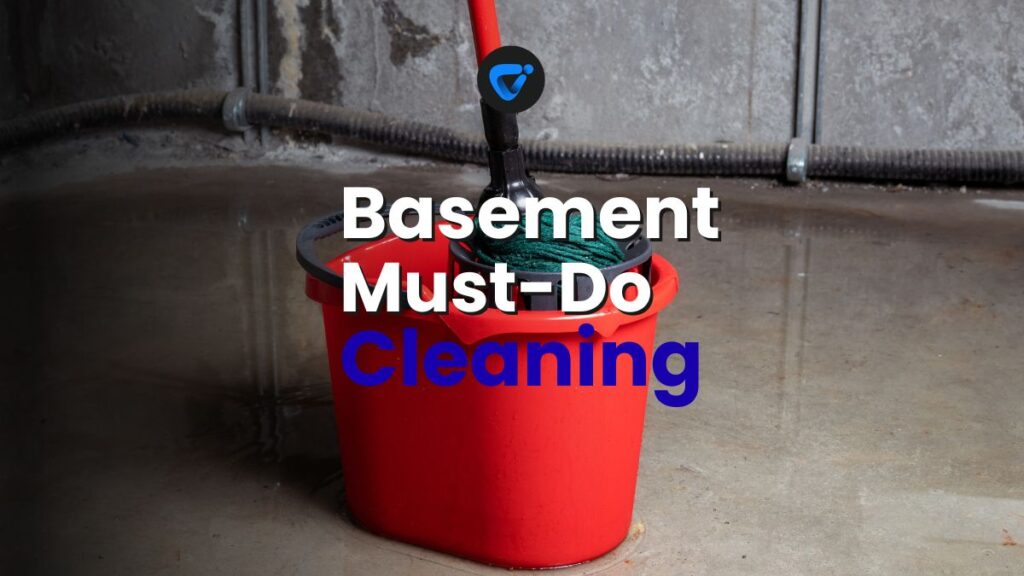
There’s a unique smell that creeps up from neglected basements and quietly claims the rest of your home. The secret culprit, lurking behind boxes and beneath stored gear, usually hides in plain sight—until it turns unmistakable. Tackling basement cleaning in time doesn’t just save your nose; it protects potential living space and keeps valuables safe.

Pantry Organization and Deep-Clean Checklist
Transform your kitchen fast! Follow our pantry organization and deep-clean checklist for a fresh, clutter-free space.
Moisture sneaks in through cracks, humid air, or forgotten leaks, giving odor-causing germs free reign. Left unchecked, what starts as a hint of must becomes a stubborn basement odor that spreads. The right basement cleaning regimen, applied on a regular schedule, holds the line against creeping damp that can get out of control.
Explore proven actions that go beyond the basics and show real results. This micro-guide walks you step-by-step, from simple prevention to deep cleaning, so your basement stays dry, usable, and fresh. Every action is field-tested, practical, and easy to start today.
Pinpoint Moisture Entry and Block It Immediately
The best way to prevent persistent odors is to shut out moisture as soon as you spot it entering. Picture a basement wall after heavy rain: you spot beads of dampness at the lowest corner, and that’s your red flag to investigate thoroughly. Consistently applying these basement cleaning steps greatly reduces future odor risks.
Sealing gaps, cracks, and window frames requires attention to detail. Drag a dry hand along baseboards and touch problem areas. You’ll sometimes feel a chill or slight dampness—those are places to act. Seal up with caulk or masonry patch, ensuring a smooth finish to keep fresh air in and dampness out.
Assess Common Leak Sources by Room Layout
Where pipes meet concrete or crawl space vents border soil, leaks strike first. Before finishing a basement cleaning routine, look along utility lines, water meters, and vents. If walls feel warmer or cooler in these zones, moisture’s finding its way in.
Check for odd stains near washer hookups or behind water heaters. Slide your hand behind appliances and use a flashlight for hidden puddles. Note colors—green or black stains can signal mold. Follow these clues as part of your seasonal routine.
Talk out loud during walkthroughs: ‘This crack looks new’ or ‘That corner’s damp after every rain.’ Taking photos helps document changes. Store the images; refer to them during every basement cleaning day to see trends or recurring problems.
Install DIY Vapor Barriers Where Needed
Plastic sheeting stapled along exposed wood joists deflects vapor away from storage. In equipment corners, double up layers for protection. Tuck edges tightly where the floor meets the wall, overlapping for a seal. This step complements a regular basement cleaning schedule.
Self-adhesive foam gaskets stick around outlets to keep out drafts and humidity. Consider installing under door thresholds, which are overlooked but can be key odor points. All materials should be cut to measure—no loose ends or gaps to trap must.
Use painter’s tape on seams while working. After a day, peel it up to see if the seal held or released moisture. Adjust as needed before putting away your basement cleaning tools.
| Location | Detection Method | Effective Sealant | Takeaway Action |
|---|---|---|---|
| Window wells | Check for condensation on glass | Silicone caulk | Seal edges and recheck next storm |
| Floor cracks | Test for seepage after rainfall | Epoxy filler | Patch, dry, confirm no repeat leak |
| Utility entries | Feel for drafts around pipes | Spray foam | Foam gaps, trim flush after curing |
| Vents & ducts | Inspect for rusty stains | Aluminum tape | Cover joints, monitor for smell return |
| Door frames | Run tissue along seams | Adhesive gasket | Install, confirm gap closure |
Eliminate Odor Sources With a Multi-Step Clean
Direct odor removal can change your basement’s atmosphere in one afternoon. Identifying what actually generates odors—be it debris, boxes, or old carpet—is pivotal to success. Every material holds smell differently, making basement cleaning a highly personalized process.
Unfinished spaces with exposed joists trap dust, while finished basements with wallboard or rugs hold onto odors from spills. Gather musty items into one part of the room and commit to cleaning or tossing each one. Some objects—like damp crates—simply shouldn’t be kept.
Remove All Loose Items and Air the Space Thoroughly
Every seasonal basement cleaning should begin with clearing clutter. Stack bins outside the door, not on damp floors. This creates access to every hidden spot and reveals unnoticed leaks beneath forgotten gear.
Open basement windows—if you have them—and use fans facing outward to pull out stale air. Carry carpets outside and shake loose dust. Letting air flow for several hours brings humidity down significantly as part of your deep basement cleaning routine.
Move boxes one at a time, not in piles. This lets you check for water marks and odd odors as you go. Mark anything questionable with colored tape to address after you finish the main clean-up.
- Empty shelves fully: This prevents dust or hidden mold from accumulating behind stored belongings and ensures every corner of your basement cleaning job is accessible.
- Discard soggy cardboard: Mold thrives in damp materials. Bag and remove any compromised storage boxes immediately to halt odor cycles before they worsen.
- Vacuum with a HEPA filter: Standard vacuums spread spores, but HEPA traps them. Make two passes over major pathways and all fabric surfaces found during basement cleaning.
- Wash hard surfaces: Mop or wipe down walls, support beams, and window frames with a mild bleach solution, avoiding harsh fumes. This breaks odor cycles lingering in woodwork or concrete.
- Launder washable fabrics: Bring upstairs any drapes, area rugs, or clothing that smells musty. Wash with hot water so clean items don’t re-introduce unwanted basement odors.
At the end of this phase, stand in the center of your cleaned basement and take a deep breath—you’ll quickly notice an improvement after a thorough basement cleaning session.
Address Deep-Set Odors With Targeted Neutralizers
- Set out baking soda trays: Open pans filled with baking soda absorb ambient smells quickly. Change weekly during your basement cleaning rotations for best results.
- Deploy charcoal bags: Charcoal naturally soaks up lingering odors from both air and fabric. Hang these in laundry corners or tuck behind boxes to target persistent pockets of musty basement air.
- Spray enzyme cleaners on spots: Enzyme products break down organic odor molecules. Spray onto affected sections—especially where pets or spills have occurred—during monthly basement cleaning runs for a residue-free finish.
- Plug in dehumidifier: Continuous use of a dehumidifier at 50% relative humidity means less moisture for odors and mold. Empty its reservoir as part of your weekly basement cleaning checklist.
- Refresh air with citrus: Peel oranges or lemons and leave the rinds on a dish in windowsills or corners. This delivers a clean scent while reminding you to revisit these trouble spots with every basement cleaning session.
Tracking which neutralizer worked in each zone will help you fine-tune your ongoing basement cleaning regimen, making future odor returns much less likely.
Maintain Consistent Air Circulation and Humidity Control
When air moves and moisture drops, odors rarely stand a chance. Good air circulation is a reliable defense, combining smooth airflow with steady humidity levels, especially during routine basement cleaning and maintenance days.
Install portable fans across from doors to push out stale air. Place a digital humidity monitor near support beams and set alerts for levels above 60 percent—at which point, pause and reassess your entire basement cleaning schedule for missed leaks or ventilation gaps.
Set Up a Rotating Fan Schedule for Even Coverage
Position one fan by the main door and another pointing toward the farthest wall. Switch fan direction weekly for broad coverage. This prevents odor build-up beneath shelves or inside storage nooks that a static air flow might miss.
When it’s breezy outside, prop open both outside-facing doors—back and side entry if available. This creates a cross-breeze, quickly flushing out indoor air trapped between walls, especially after a big day of basement cleaning.
Large basements benefit from oscillating fans that move automatically, while small basements call for adjustable box fans clipped to shelving. Monitor which set-up helps the floor dry fastest after mopping during each basement cleaning.
Use Humidity Monitors to Guide Daily Action
Mount a battery-powered humidity reader at eye level on a central support post. Glance at the reading during every basement cleaning check-in. Make adjusting the dehumidifier setting part of your daily routine.
Record spikes or dips on a simple paper chart on the refrigerator. This snapshot lets you spot patterns after laundry day or heavy rain. Respond quickly with extra fan use or by opening windows, keeping odors under control as part of regular basement cleaning.
If readings stubbornly exceed 60 percent for days, check for a missed leak or condensate line. Tackle the source, then return to testing. Proactive tracking makes future basement cleaning much simpler and keeps the environment dry.
Safeguard Belongings and Surfaces From Odor Absorption
Protecting your items during every basement cleaning session prevents them from absorbing must and mildew. Clear tubs and shelving, paired with space-saving strategies, help everything stay fresh and extend the life of stored possessions.
Choose airtight plastic bins for linens and papers. Avoid cardboard, which soaks up moisture and becomes a breeding ground for odors and mold—especially after minor flooding or high humidity spells. Label each bin with contents and ‘last cleaned’ date during basement cleaning periods.
Elevate Storage to Prevent Contact With Damp Floors
Place shelving units on rubber feet or low pallets to raise items off concrete. This simple lift keeps air flowing underneath and allows you to mop or vacuum easily each time you do deeper basement cleaning.
On the first shelf, stow infrequently used items—holiday décor, keepsakes, archived papers. Second shelf: place regularly accessed bins, so you avoid excess handling and limit exposure to damp air. Higher placement means less risk if leaks develop between basement cleaning sessions.
Check beneath shelves every month for damp spots and wipe these areas down, marking each shelf corner with a colored dot sticker to confirm where you’ve inspected between thorough basement cleaning visits.
Shield Textiles With Odor-Blocking Covers
Large textiles like sleeping bags, curtains, and spare uniforms require extra defense. Store inside sealed bags with one perforated dryer sheet (unscented works best) for a neutral smell. Rotate these bags out every three months at minimum, aligning the schedule with seasonal basement cleaning chores.
On laundry days, lay out stored fabric on a clean outdoor surface for a brief air-out session. Sunlight helps neutralize lingering smells picked up between basement cleanings. Fold and rebag only after the fabric feels completely dry.
Hang quilts or large blankets from bicycle hooks mounted on ceiling beams to air them out for hours after each basement cleaning. Remember to reposition hooks occasionally to avoid compression marks on thicker items.
Adopt a Routine Basement Cleaning Schedule for Long-Term Prevention
Scheduled cleanings make healthy basements a reality. Create a routine that covers daily, weekly, and monthly tasks. Set reminders on your calendar and stick to them. Consistency is the main difference between must-free living spaces and those with persistent odors.
Your schedule should adapt to season, humidity, and household use. In rainy periods, switch to weekly deep-cleaning mode. During dry seasons, monthly touch-ups may be sufficient for odor control as part of your regular basement cleaning approach.
Daily, Weekly, and Monthly Task Checklists Keep You On Track
- Inspect for leaks daily: Run a quick hand-check on all pipes and wall joints. Spotting moisture early lets you jump straight into targeted basement cleaning before odors appear.
- Vacuum walks and shelves weekly: Use a HEPA vacuum along carpet, concrete, and storage nooks. This stops dust buildup that doubles as food for mold.
- Air out the basement every weekend: Open windows and run fans for two to three hours. This refreshes air and prevents stagnant zones where must can originate between more thorough basement cleanings.
- Mop or wipe floors and surfaces monthly: Mix a mild disinfectant solution for floors and walls. With regular mopping, you minimize risks of buildup, stains, and that characteristic damp basement smell.
- Change dehumidifier and air purifier filters monthly: Fresh filters mean better moisture removal and odor control. Mark ‘filter change’ on your calendar for the same day you do your deep monthly basement cleaning.
Catch up with your checklist on weekends or right after heavy rainfall. The key to successful basement cleaning is never letting small issues grow into odor emergencies.
- Store seasonal gear in labeled, airtight bins: This keeps odors sealed out and lets you track contents and last-cleaned dates during every quarterly basement cleaning. Rotate as seasons change, inspecting each bin for new smells or damp spots.
- Move furniture off direct floor contact: Use furniture risers or rubber feet to lift legs, making it harder for basement moisture to creep up. Reposition chairs and tables during periodic cleaning days for full access underneath.
- Check sump pump operation monthly: Pour water into the sump well to check response and sound. Mark any sluggishness in your maintenance log so it’s not forgotten before your next round of basement cleaning.
- Maintain uncluttered access paths: Leave three feet of open walkway along main routes to ensure you reach all corners and pipes. This encourages more regular cleaning by making your basement more inviting and manageable.
- Log changes and repairs: Keep a notebook or app list to date every fix, cleaning, or leak. Reviewing this record helps set priorities for each future basement cleaning run.
Stick to this checklist and your basement will remain fresh, functional, and always ready for guests or storage.
Conclusion: Sustain a Fresh, Dry Basement for the Long Haul
Odor-free, comfortable basements require intentional effort—never guesswork. Regular basement cleaning, using clear steps and routines, ensures each season brings a space you’re proud to share, not a zone to dread.
Taking the time for moisture checks, targeted odor removals, and organized storage pays you back in peace of mind and valuable space. Each detailed basement cleaning action outlined above benefits everything you store and every person who steps downstairs.
If you treat basement cleaning as a small but rewarding part of your home care, you’ll notice fresher air, fewer worries about moisture, and a lighter, more appealing home from top to bottom.
Frequently Asked Questions
For best results, do a deep clean every month, with targeted mini-sessions following spills, heavy weather, or laundry mishaps. This keeps dust, odors, and mildew at bay year-round.
Both help. Fans circulate air and dry surfaces after cleaning, while a dehumidifier maintains steady moisture levels. Together, they work best against lingering smells and condensation issues.
Diluted bleach works for disinfecting concrete and tiles, but always ventilate well. Avoid it on finished walls or porous stone to prevent damage. Consider vinegar water for regular wipe-downs.
Remove problematic items for separate airing or deep-wash cycles. If odor lingers, consider discarding or entrusting to a professional cleaner. Don’t let one item sabotage your entire basement environment.
Place paper or dry mats at likely trouble spots—by foundation walls, under piping, or below windows. Change at the first sign of moisture, then investigate and seal during your next basement cleaning round.

How to Make Living Room Surfaces Dust-Free
Keep your living room spotless! Learn simple tricks to make surfaces dust-free for longer and breathe cleaner air.


